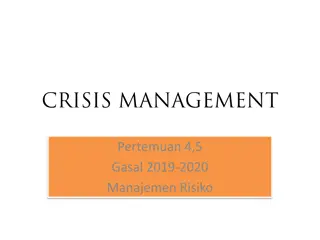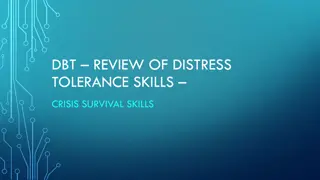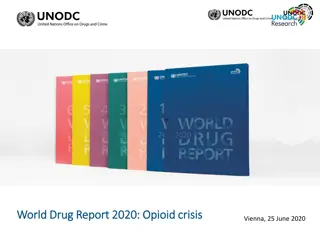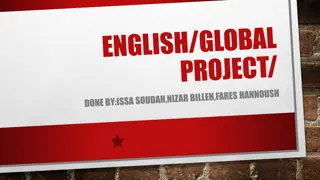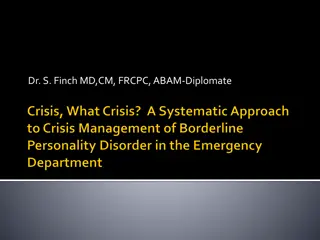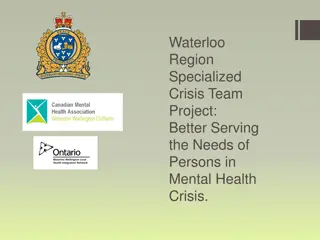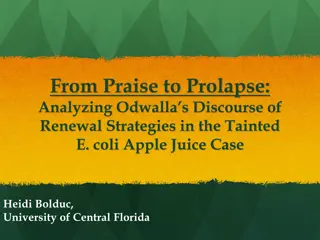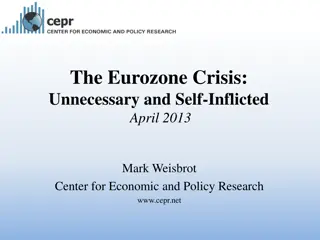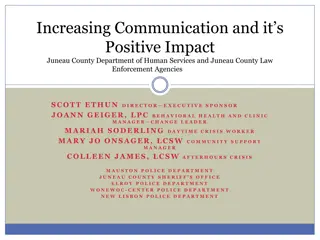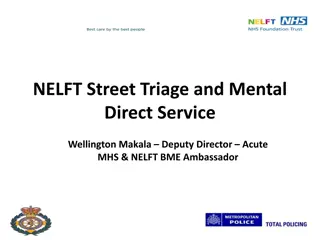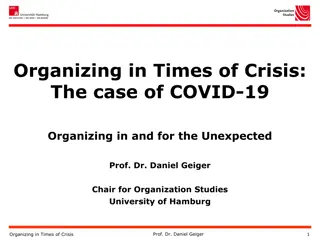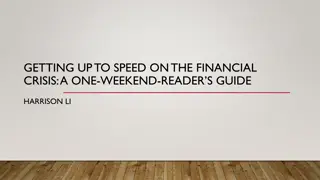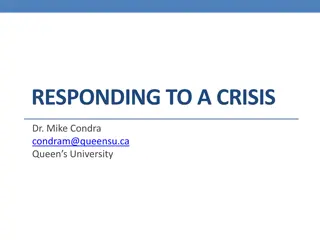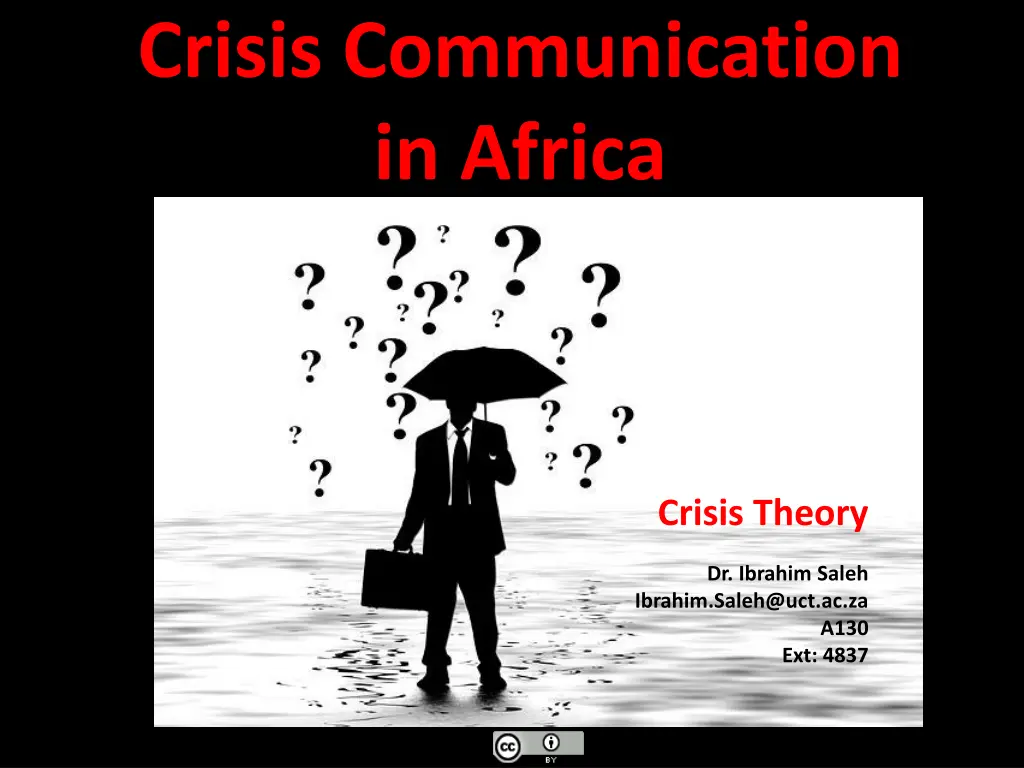
Crisis Communication in Africa: Understanding the Stages and Strategies
Explore the concept of crisis communication in Africa, covering the definition of a crisis, stages of a crisis, disaster risk reduction, and risk management. Learn about the importance of strategic media communications in crisis situations and the evolution in risk reduction approaches.
Uploaded on | 3 Views
Download Presentation

Please find below an Image/Link to download the presentation.
The content on the website is provided AS IS for your information and personal use only. It may not be sold, licensed, or shared on other websites without obtaining consent from the author. If you encounter any issues during the download, it is possible that the publisher has removed the file from their server.
You are allowed to download the files provided on this website for personal or commercial use, subject to the condition that they are used lawfully. All files are the property of their respective owners.
The content on the website is provided AS IS for your information and personal use only. It may not be sold, licensed, or shared on other websites without obtaining consent from the author.
E N D
Presentation Transcript
Crisis Communication in Africa Crisis Theory Dr. Ibrahim Saleh Ibrahim.Saleh@uct.ac.za A130 Ext: 4837
There were very poor communications at the time. We weren't able to get clear, accurate information out to the media and the public. ... And at that point the media went to other sources for their information." Tom Kauffman
What is a crisis? Crisis: an unstable or crucial time or state of affairs whose outcome will make a decisive difference for better or worse (Webster's New Collegiate). Crisis management: a systematic response to unexpected events that threaten the people, property and operating continuity of the organization. The role of the media: (should be) provide balanced views to allow the public to shape informed opinions and make informed decisions.
Stages of a Crisis 1. Crisis build-up hints or cracks appear 2. Break-out triggering event causes the crisis to erupt 3. Lessening (abatement)-linger for years 4. Termination- when the crisis is no longer a threat or has caused the demise of the entity involved Strategic media communications are essential at every stage.
An evolution in approach To Risk Reduction From Response and Relief 5
What is Disaster Risk Reduction? The conceptual framework of elements with possibilities to minimize: Hazards Vulnerabilities and therefore disaster risks to: Avoid (prevent) or Limit (mitigate and prepare for) The adverse impacts of hazards within the broad context of sustainable development 6
Risk management What is risk? The probability of suffering damage (to life, property, economic disruptions and environment) from a hazard for a given area and reference period. Risk is the product of hazard and vulnerability 7
Disaster Risk management The process of identifying, analyzing and quantifying the probability of losses in order to undertake preventive or corrective actions This involves two types of activities ; Planning actions to reduce vulnerability in areas where risk can be controlled, and Establishing protective mechanisms against the potential economic losses from uncontrollable factors of natural hazards 8
Risk Management Entails efforts and measures put in place to reduce risk in case of a disaster happening Commitments related to disaster and vulnerability reduction and improved early warning 9
Shared Risk (Aldoorya, Kimb &Tindall, 2010) Perceived shared experience with a media portrayal could influence various cognitions such as concern, sense of personal involvement, and desire to learn more that are important for behavior change.
The Situational Theory of Publics Factors; including problem recognition, level of involvement, and constraint recognition influence the individuals infnormation process about a problem and the cognitive need to seek out more information about a problem. "Perceived similarity" is the extent to which an audience member believes a media portrayal reflects their own personal characteristics (Andsager, Bemker, Choi, & Torwel, 2006; Austin & Meili, 1994). Findings (agenda setting and cultivation) emphasized a close link between the perceived similarity to characters portrayed in mediated campaigns and the more likely that identification and modeling will occur, which then lead to greater intent to change behavior (Andsager et al., 2006).
Information-seeking behavior is what characterizes the active players in a public opinion issue (Slater, Chipman, Auld, Keefe, & Kendall, 1992, p. 190). But with information processing, members of a public do discover or recognize a message although the message is not necessarily acted upon (Aldoory, 2001; Grunig, 1989; Slater et al., 1992). But in almost all cases, individuals lack direct experience (obtrusive) with the risks associated with major crises, they rely on others to interpret technical jargon and threat, and then they negotiate the boundaries between the scientific and their everyday world. Without the ability to directly assess the risks and benefits (unobtrusive),the public rely on information provided by experts (Siegrist & Cvetkovich, 2000, p. 714). As Berger (2003) argued, the ways in which the news media present stories about potentially threatening phenomena may be among the more influentialcause of distorted risk perceptions (p. 251).
Media Effects Research assess systematically how people perceive crisis situations and crisis response strategies (Coombs & Holladay, 2009). Print and video differ as channels. Video messages have the ability to deliver relational, nonverbal, and verbal cues as well as to create a "face" for the message. Drawing on Meyrowitz s (1985) work, Pfau and Wan (2006) suggest televised (video) messages lead viewers to focus on the message source while print leads readers to focus on the message content. The Elaboration Likelihood Model suggests televised messages would be more likely to be processed on the peripheral route because it requires minimal involvement while print messages would be more likely to be processed on the central route (Pfau & Wan, 2006). Crises are largely a mediated experience for the vast majority of stakeholders, especially non-victims.
Mistakes in Crisis Communication If media does not provide comprehensive information If the representative/ spokesperson did not go to the crash site quickly enough If authorities fail to deal with circulating conspiracy theories fuelled suspicions If not using the Golden hour and taking too long to respond to the public and complete investigation
Planning for a crisis Prepare contingency plans in advance Crisis management team members should be the only the people who speak to the media Give accurate and correct information because manipulating information can backfire Action plans should consider both the short term and long term
The Crisis Game An opportunity for change Transparent message of integrity Effective strategy to improve/instil values Make the media your friend, not your enemy BUT how you start is how you ll end
"A good reputation is more valuable than money. " Publilius Syrus, Roman author 1st century BC
This presentation is licenced under the Creative Commons Attribution 2.5 South Africa License. To view a copy of this licence, visit http://creativecommons.org/licenses/by-sa/2.5/za/ Or send a letter to Creative Commons, 171 Second Street, Suite 300, San Francisco, California 94105, USA.

